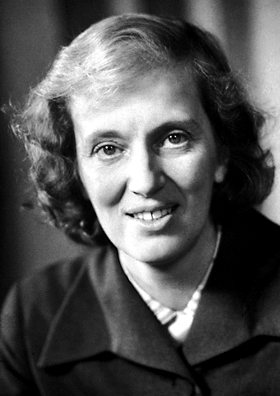“ I was captured for life by chemistry and by crystals” - Dorothy Hodgkin (The Oxford Dictionary of Quotations)
I think it is important that we honour the female scientists who played a role in paving the way for women in the science and math fields of today. There are hundreds of amazing women who have been forgotten about, and Dorothy Hodgkin is one of them. Hodgkin was not only a scientist, but an activist and pioneer in the field of X-ray crystallography.
Hodgkin’s parents were prominent figures in the world of archaeology and she grew up visiting them in various destinations including Sudan and Cairo. From the ages eleven to eighteen, Hodgkin was one of only two girls who were allowed to join the boys for chemistry class -- by the time she graduated from that school, she knew she wanted to study chemistry (Nobel).
Hodgkin proceeded to excel in science and she was one of the pioneers of x-ray crystallography after deciding to study the topic for her fourth year research assignment at Somerville College (Chemistry Heritage Foundation). After graduating from Somerville, Hodgkin moved on to study at Cambridge with a physicist named John Bernal (Encyclopedia Britannica). She remained at Cambridge and completed her doctoral studies but eventually returned to Somerville after being offered a research fellowship. Hodgkin remained at Somerville and taught for nearly forty years before she retired (Nobel).
During the time she spent teaching, Hodgkin made major discoveries including vitamin B12 and the structures of insulin and penicillin. Hodgkin received many honours including being the second woman to be elected to join the Royal Society, and being the third women to win the Nobel Prize in chemistry (Nobel).
In addition to being an inspirational scientist, Hodgkin was a humanitarian. Hodgkin took a special interest in bringing together scientists from around the world. Eventually Hodgkin became president of the Pugwash Conferences on Sciences and World Affairs, an organisation whose main goal was to promote the peaceful use of science (Chemistry Heritage Foundation).
I think that women like Dorothy Hodgkin are the kinds of people we should be looking up to. When Hodgkin was studying and working it was still unusual to see women working in science and it was women like her that paved the way for us. There were probably many other women who would have liked to have studied science but didn’t have the means or the courage to break out of the status-quo. Thanks to women like Hodgkin, women are able to work in any field they want to without penalty.
Do you think you would have the courage to be one of the first men or women to work in a field that was still dominated by the opposite sex?
